The Thermal Data
In a change from the 360mm thermal testing, all other radiator sizes are only going to be tested at 1.0 GPM. We proved that for 95% of the rads tested, flow rates over 1.0 GPM did not make any significant impact on the radiator performance. The decision to only test at 1.0 GPM is also because of the time required to complete this testing, and running the additional flow rates effectively doubled the required test time.
A total of 6 tests were conducted at 1.0 GPM with fan speeds of 750 rpm, 1300 rpm and 1850 rpm being run in Push Only and Push/Pull. All inclusive this testing still takes between 40 – 50 hours of logging time to get the results that are presented.
Below is the final data results gathered from at least 5 data logging runs at the flow rate and fan rpm combination. The most stable 15 minute period from each logging run was used and then averaged with the other runs to obtain the data for the table below. A total of 16 temperature sensors were used in the thermal test chamber (8 air in, 2 air out, 3 water in, 3 water out) each take a reading every second and logged via a CrystalFontz unit.
The data in the table below is the averaged results of the logging runs which has then been used to create all the plots and tables there-after.
The performance metric of critical importance is the delta between the warm coolant temperature in and the cold ambient air temperature in to the radiator. Given that the system is well insulated and in equilibrium and we know the heat input to the system then we can also calculate a very important number – that is the amount of power required to raise the coolant temperature 1C (or 10C which is a more useful reference point).
Let’s take a look at the Delta T results from the tests. Note that the extrapolation of the curve is much more sensitive to error than in between the tested range.
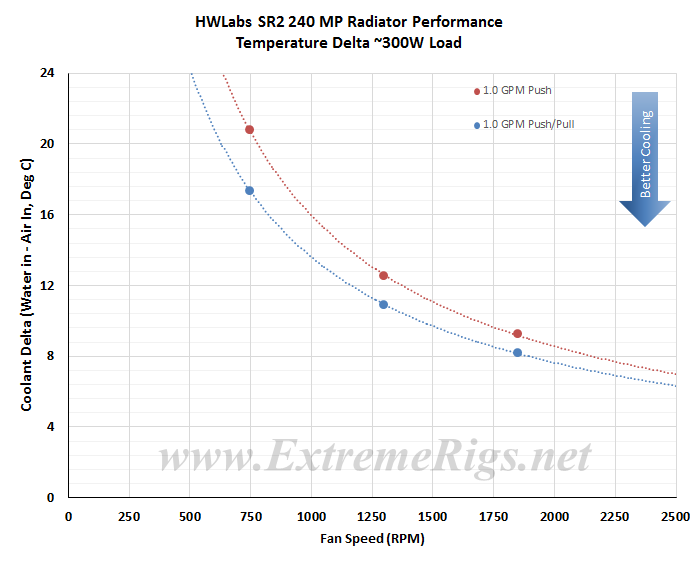 I was not too concerned about the actual delta numbers, more so the trend pattern, and as we should expect, the deltas come down significantly as the fan speed is increased.
I was not too concerned about the actual delta numbers, more so the trend pattern, and as we should expect, the deltas come down significantly as the fan speed is increased.
Remember back when I was cringing at HWLabs style of presenting the performance rating of 950 watts with a 25°C Delta, well doing the maths on our Push/Pull 1850 rpm test result with an adjusted delta of 25°C we end up with a power dissipated result of 962 Watts. This is of course pure coincidence that our results are so close given the difference in setups and has no real meaning but I found it to be a fun trivia fact and it gives credence to the HWLabs data.
Delta T results (as above) are not always helpful when thinking about how many radiators you would need to cool your system. Instead it’s more useful to know the delta/W, or more usefully, the inverse metric of W/delta C. The metric plotted below tells us how many watts are dissipated by the radiator when the coolant rises 10C above ambient temperatures. (W/10 Delta T):
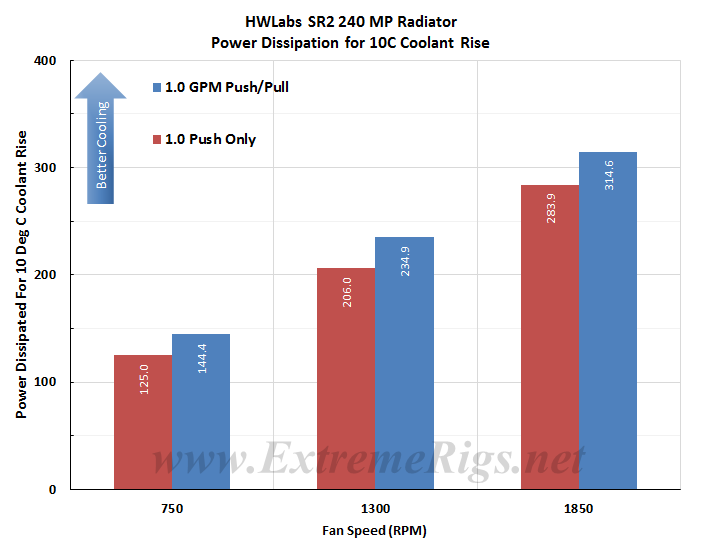 This same data can now be plotted on a chart so that an end user can interpolate their own fan speed. Note again that the extrapolation of the curve is much more sensitive to error than in between the tested range.
This same data can now be plotted on a chart so that an end user can interpolate their own fan speed. Note again that the extrapolation of the curve is much more sensitive to error than in between the tested range.
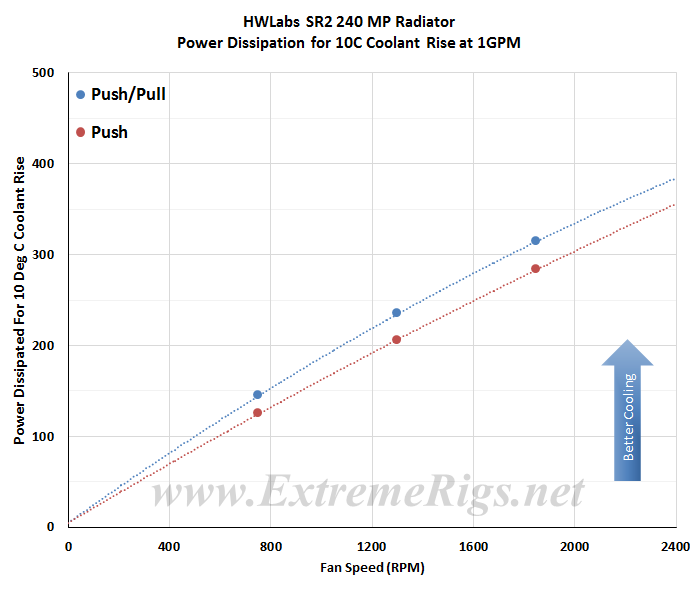 With the SR2’s low fin count of 9 FPI, the results show that a Push Only fan assembly is very efficient on this radiator at all RPM’s, and that adding a second set of fans (Push/Pull) only yields an average performance increase of ~12%.
With the SR2’s low fin count of 9 FPI, the results show that a Push Only fan assembly is very efficient on this radiator at all RPM’s, and that adding a second set of fans (Push/Pull) only yields an average performance increase of ~12%.
Now let’s analyze that data some more…







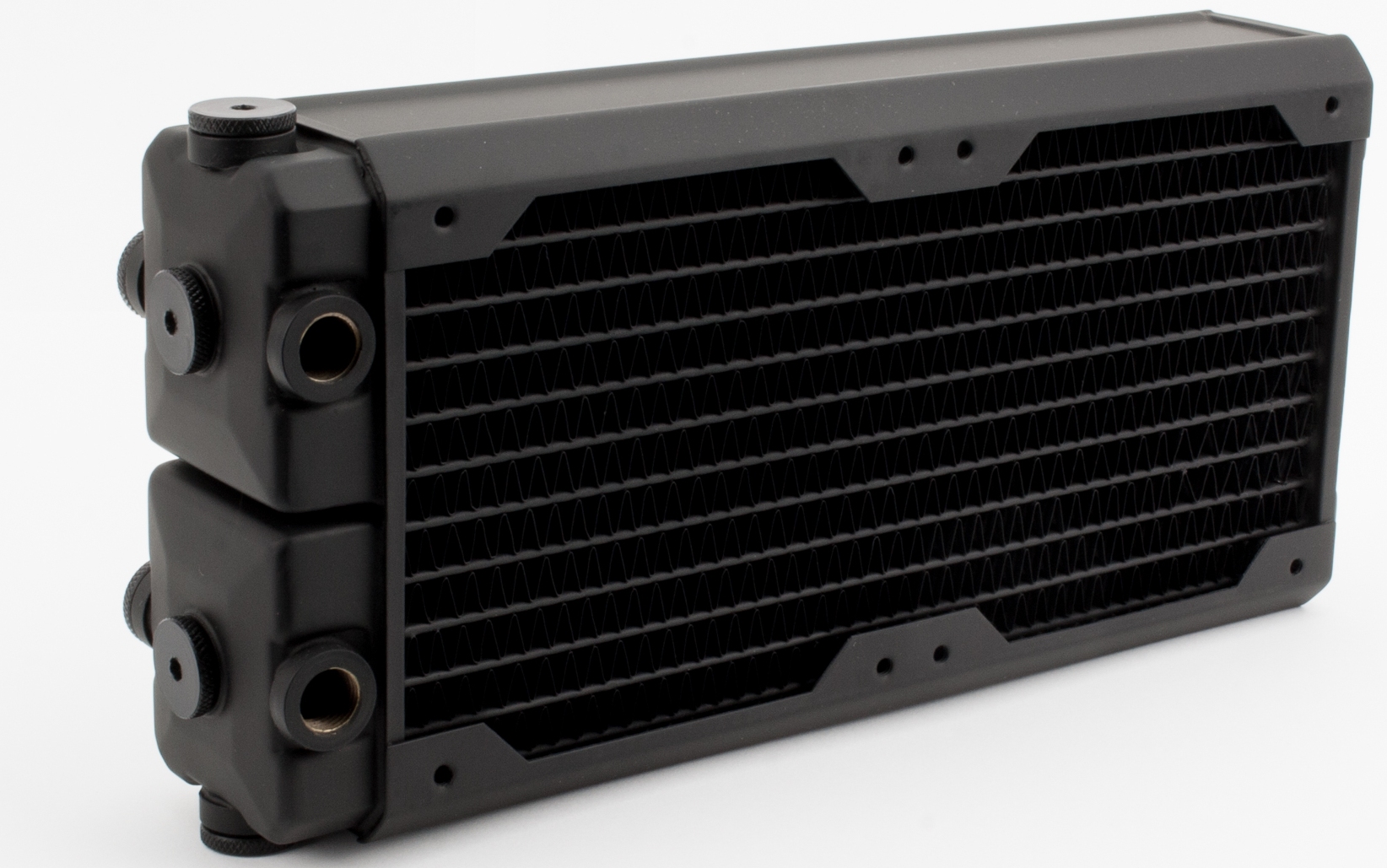
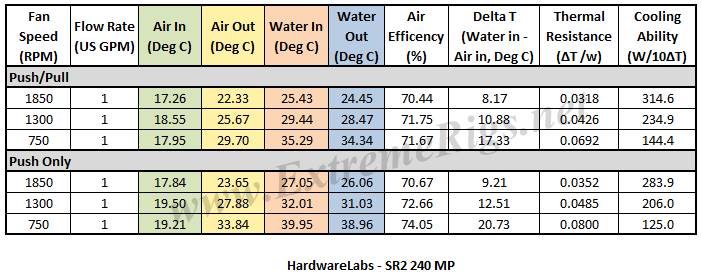




Maybe slightly disappointing thermal results, but not a deal breaker. Swarf in rad not a deal breaker either. Flexibility of ports, flexibility of use/fan rpms and overall quality mean that this is still a very good radiator. Again: great test. Now, please get more 240 results!
Often written or said in radiator reviews, “Since the XXX size of brand X radiator has shown XYZ level of performance, one should expect like performance from up-size XXX (or) down size XXX.” If the ratio of/comparable performance of the SR2 240 MP falls short of the SR2 360 MP, should we expect the 480 to provide an additional boost in performance over the 360 or similar performance to the 360? Given what the test results of the 240 tell us, how can an answer to either possibility be justified?
Not sure quite what you’re trying to say Questors – can you explain again?
The 240 performs at about 70% of a 360 when using an equal heatload. However it is running more efficiently as an equal heatload equates to a higher delta T. The 240 *should* of course be 66% of the the 360 and I do believe that it would give us that result if we kept a constant delta T instead of a constant heatload.
So to answer the question – should the 480 provide an additional performance boost over the 360? Absolutely – yes it should. As to how much – we would expect the ideal 33% more cooling ability when measuring a constant delta T, however for a constant heatload you would some efficiency because the delta T would be lower. So to guess – somewhere between 25-30% better cooling.
Does that answer the question?
This was the basis for me asking the question: “However, the thermal Test conditions did not favor the 240mm variant quite as well as the 360mm. The consistency was still there but performance was weaker when compared to the same competitor.”
To me this meant the performance of the SR 240 vs the XE 240 was less proportionate to the SR2 360 results against the XE 360.
Your response clears things up for me – “a constant delta T instead of a constant heatload”
[…] EK XE 240 Radiator Hardware Labs SR2 240 Radiator […]
Comments are closed.